It’s nice to have options, and the city last week offered some details on the one it has given to Ground Zero developer Larry Silverstein—a choice to lock the city into a 15-year lease for nearly 600,000 square feet in one of the new World Trade Center towers, for a total price tag of $577 million.
The city granted the option in September 2006, as part of a deal with the Port Authority, New York state and Silverstein Properties over control of the WTC site. But ahead of a contract hearing on Wednesday about the lease, the city revealed new details on the deal’s scope, duration, escalating rent and total bill. The city would occupy 581,642 square feet – comprising all of the 7th through 21st floors of Tower 4 – and would pay rent beginning at $56.50 per square foot, rising each year for the next five years and then jumping again in the 10th year of the lease to $73.21 per square foot.
What the city didn’t reveal is which agencies will use the space, because they don’t know yet. Indeed, while the city leases some 22.5 million square feet of space around the city each year, the Tower 4 deal is unique: It applies to a building that doesn’t exist yet, provides space that has no identified need and probably wouldn’t be used until 2013.
That’s if the lease ever takes effect. Silverstein has until the end of 2009 to execute his option and make the lease binding. Leases on Class A office space in Lower Manhattan went for an average of $53 at the end of last year, but the price had increased 17 percent just over the course of 2007. Since Silverstein’s most recent leases at his rebuilt 7WTC are closing at a reported $70 a square foot, the developer might decide that the city’s deal is too cheap. “The cost per square foot that the city is paying is well below market for Class A space and especially new space downtown,” says Dara McQuillan, a spokesperson for Silverstein Properties. On the other hand against a backdrop of a softening national and local economy what the city’s deal lacks in lucre it makes up for it in certainty.
Silverstein entered into a 99-year lease with the Port Authority for the World Trade Center in the spring of 2001. After the towers were destroyed, Silverstein received insurance payments of around $5 billion, which he’s using to pay for rebuilding and cover his monthly rent to the Port Authority.
Under the 2006 agreement with the city and Port Authority, Silverstein controls construction and leasing for Towers 2, 3 and 4 while the Port Authority has authority over the Freedom Tower and Tower 5. In that deal, the Port Authority agreed to occupy another 600,000 square feet of Tower 4 and move its headquarters there, meaning that the city and Port Authority would inhabit two-thirds of the office space in the 64-story building. The Port Authority finished excavation for Tower 4 – a.k.a. 150 Greenwich Street – on Feb. 17 and turned the site over to Silverstein for construction, which is expected to last through 2011.
~
The Port Authority has commitments from state and federal agencies for 1 million square feet of the Freedom Tower, about half the building. Brad Maione, a spokesperson for the state Office of General Services, refused to comment on whether any state agencies had actually signed leases. The federal General Services Administration says it is negotiating with the Port Authority for 650,000 feet in the Freedom Tower, most of which will be used by the Department of Homeland Security.
The feds lost a significant amount of office space on September 11: offices for the Customs Service, IRS, Secret Service, Department of Defense, Equal Employment Opportunity Commission and, according to some reports, the CIA. New York state lost court and tax department offices. The city, however, had a fairly small presence before the attacks, limited to the single floor of 7WTC where Mayor Rudy Giuliani located his ill-fated emergency command center.
So, if Silverstein executes the option, the city’s presence at the WTC site will increase markedly over its pre-Sept. 11 footprint.
That’s not a problem for at least some downtown interests. “It’s a great thing,” says Catherine McVeigh Hughes, who chairs Community Board 1’s committee on WTC rebuilding. “For us, whether it’s public or private, it’s great that people are leasing downtown.” While the city’s Department of Administrative Services is officially in charge of leasing city office space, the New York City Economic Development Corporation is taking the lead on the Tower 4 deal – a signal that the transaction is as much about boosting the rebuilding process as it is about securing needed space for city offices.
Critics of the original World Trade Center development faulted the towers’ dependence on government tenants as evidence of a mismatch between the massive towers and the marketplace for office space. At one point in the 1970s, some 1.5 million square feet – about a fifth – of WTC 1 and WTC 2 were vacant. In the mid-1980s, state agencies occupied at least 57 floors of the two buildings.
But those critics have been absent from any discussion about the city’s pending lease deal. Community Board 1 did not weigh in on it, Manhattan Borough President Scott Stringer offered no recommendation, and when the City Planning Commission held the land use hearing on it last April, no one testified. At Wednesday’s hearing on the contract, there was but one speaker: Kay Dunham, an inveterate gadfly who is often the only attendee or commenter at the city’s biweekly contract hearings. Her advice on the Tower 4 deal? “I think they should condo it and see to it that they have something as the years go by.”
With rebuilding only recently seeming to gather steam, it’s possible that the space won’t be ready until even later than 2013. “We have milestones and provisions that protect the city in the event there is a delay in construction. However, we are confident that construction will proceed apace,” says Janel Patterson, spokeswoman for the Economic Development Corporation. Once Silverstein is finished building, the city would probably have to do some work to make the space suit its uses – and the city would cover those costs, too. “Like any other tenant, the city will ultimately pay for its improvements. The lease is flexible as to how that cost is spread out over time,” Patterson adds.








